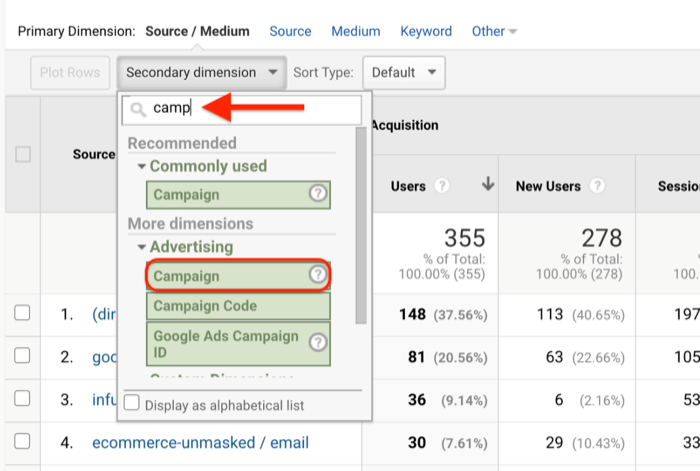Deep Study the 'Secondary Dimension' in Google Analytics: Everything You Need To Recognize
Wiki Article
Navigating the Midst of Secondary Measurement in Google Analytics: A Thorough Exploration on Its Capability
In the world of electronic analytics, the intricacies of information analysis often hold the key to opening useful insights. Within the expansive toolkit of Google Analytics lies a feature that acts as a surprise gem for those that look for a much deeper understanding of individual behavior and web site efficiency. Additional dimensions, though seemingly simple in the beginning glance, nurture a wide range of untapped possible waiting to be harnessed. As we get started on this trip to discover the nuanced performance of additional dimensions, we will reveal just how this feature can illuminate patterns, unveil correlations, and ultimately lead the means for informed decision-making in the digital landscape.Recognizing Secondary Dimensions in Google Analytics

Understanding just how second dimensions job is vital for leveraging the complete power of Google Analytics. By combining primary metrics with secondary measurements, you can acquire valuable understandings that drive informed decision-making and optimization techniques.
Leveraging Secondary Dimensions for Information Analysis
Building upon the fundamental understanding of just how additional dimensions boost information analysis in Google Analytics, the use of these additional layers of details ends up being extremely important in extracting beneficial understandings for notified decision-making and optimization strategies. By leveraging additional dimensions, experts can delve much deeper right into the efficiency metrics by adding more context to the main dimensions, hence revealing surprise patterns and connections that might not be evident in the beginning look. This much deeper degree of analysis makes it possible for companies to much better understand individual habits, determine trends, and determine locations for improvement.
Moreover, secondary measurements give a more detailed sight of the information, permitting segmentation based upon various specifications such as demographics, gadgets, web traffic resources, and more. This division assists in a more granular analysis, allowing companies to tailor their methods and projects to specific target market sectors for boosted targeting and personalization. In significance, the strategic use secondary measurements empowers organizations to make data-driven choices that drive growth and success in the digital landscape.
Advanced Methods for Second Measurement Application
Exploring complex methods to harness the complete capacity of second dimensions in Google Analytics boosts the deepness and class of data analysis for critical decision-making. One sophisticated strategy for implementing secondary measurements is making use of custom dimensions. By specifying customized measurements, customers can section information even more to obtain even more specific insights right into customer behavior, such as tracking communications with specific elements on a web page or keeping track of the efficiency of a certain advertising campaign. An additional advanced technique is the use of regex (routine expressions) within second dimensions. Regex permits for even more adaptable and powerful pattern matching, enabling individuals to develop complex filters for data analysis. Additionally, integrating second dimensions with sophisticated sections can offer much more granular understandings by applying numerous layers of division to the information. This method enables for a much deeper understanding of individual behavior based on various criteria at the same time. Implementing these advanced techniques for secondary measurements in Google Analytics encourages users to conduct much more advanced evaluation and make data-driven choices with accuracy.Interpreting Insights With Second Dimensions

When translating insights with additional measurements, it is important to think about the context of the data and how different dimensions communicate with each other. Understanding which specific web traffic sources lead to greater conversion prices or identifying which tools individuals prefer for making acquisitions can provide workable insights for enhancing marketing campaigns and boosting overall web site performance. By very carefully taking a look at the data with additional dimensions in mind, businesses can make educated decisions that drive purposeful outcomes and boost their digital presence.
Maximizing Performance With Secondary Measurements

One crucial means to enhance performance with second dimensions is by segmenting data more granularly. This enables you to isolate specific aspects that might be influencing your metrics and obtain a better understanding websites of what drives success or failure in your digital efforts. For example, by integrating additional measurements such as 'device classification' and 'touchdown page,' you can determine which tool kinds are most reliable for particular landing web pages, allowing you to customize your methods as necessary.
In addition, making use of second dimensions can aid you identify fads, patterns, and connections that may not appear when analyzing data with key measurements alone. This much deeper level of evaluation can bring about more enlightened decision-making and eventually enhance the overall efficiency of your web site or electronic advertising and marketing projects.
Verdict
In final thought, secondary dimensions in Google Look At This Analytics play an essential role in improving information analysis and offering deeper insights right into internet site performance. By making use of innovative methods more information and interpreting the data efficiently, organizations can maximize their strategies and boost general efficiency. Understanding the functionality of secondary dimensions is important for making informed choices and driving success in the digital landscape.By leveraging additional dimensions, experts can dig much deeper right into the performance metrics by including more context to the main measurements, therefore discovering concealed patterns and relationships that might not be evident at initial glimpse. One innovative technique for executing second dimensions is the use of personalized measurements.Having actually grasped sophisticated strategies like custom dimensions and regex for secondary measurement application in Google Analytics, the next crucial step is interpreting the valuable insights derived via these sophisticated data segmentation methods. Analyzing insights through additional dimensions entails analyzing the connections between the primary and second measurements chosen, revealing patterns, fads, and relationships that may not be right away apparent when looking at the data in its whole.When translating understandings via additional measurements, it is necessary to think about the context of the information and just how various measurements interact with each various other.
Report this wiki page